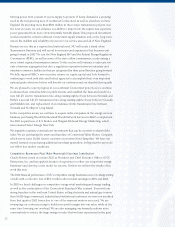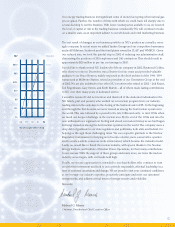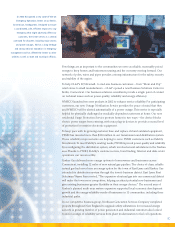Eversource 2002 Annual Report Download - page 18
Download and view the complete annual report
Please find page 18 of the 2002 Eversource annual report below. You can navigate through the pages in the report by either clicking on the pages listed below, or by using the keyword search tool below to find specific information within the annual report.
16
WMECO recorded net income before the payment of preferred dividends
of $37.7 million in 2002, compared with $15 million in 2001. The
improved 2002 results were largely due to the recognition of $13 million
in investment tax credits and the elimination of $9 million of reserves,
both in 2002, as a result of regulatory decisions. North Atlantic Energy
Corporation (NAEC) earned $26.3 million in 2002, compared with
$4.2 million in 2001. The improved 2002 results were largely due to the
elimination of a Seabrook-related reserve during 2002. On November 1,
2002, NAEC sold its 35.98 percent share of Seabrook. Subsequently, a
portion of NAEC’s equity was repaid to NU. NAEC’s operations will
not have a material impact on NU’s consolidated financial results in
2003 or thereafter.
Competitive Energy Subsidiaries: The decline in NU’s 2002 earnings was
primarily a result of disappointing results at NU’s competitive energy
subsidiaries. In 2002, those businesses lost $54.1 million, or $0.42 per
share, compared with earnings prior to the charge associated with the
adoption of SFAS No. 133 of $5 million, or $0.04 per share, in 2001 and
a contribution towards NU’s consolidated earnings of $13.6 million, or
$0.10 per share, in 2000. Select Energy’s wholesale marketing business
was essentially break-even in 2002, following a loss of approximately
$13 million in 2001. Those results include the performance of Northeast
Generation Company (NGC) and Holyoke Water Power Company
(HWP). Select Energy’s retail marketing business experienced weaker
performance during 2002, with losses of approximately $28 million,
compared with 2001 losses of approximately $8 million, excluding the
loss associated with the adoption of SFAS No. 133, as amended. Select
Energy’s trading business also lost approximately $24 million in 2002
compared with earnings of $19 million in 2001. NU’s energy services
businesses, including Northeast Generation Services Company (NGS)
and Select Energy Services, Inc. (SESI), were essentially break-even in
2002. SESI earned $3 million while NGS lost $3.2 million. In 2001, SESI
earned $2.4 million and NGS earned $4.6 million. In 2002, NU
Enterprises, Inc. (NUEI) and the energy services subsidiaries of Yankee
lost approximately $2 million.
Future Outlook
Consolidated: NU estimates that it will earn between $1.10 per share
and $1.30 per share in 2003.
Regulated Utilities: The earnings range of between $1.10 and $1.30 per
share includes earnings of between $1.05 per share and $1.15 per share
at the regulated businesses, compared with aggregate earnings of $1.72
per share at the regulated businesses in 2002. The primary reason for
the earnings reduction at the regulated businesses in 2003 is the sale of
Seabrook in 2002 and the resulting elimination of operating earnings at
NAEC in 2003, the recording of $13 million of tax credits at WMECO in
2002, and a significant reduction in the projected level of pension
income in 2003 and forward.
NU recorded $73.4 million of pre-tax pension income in 2002,
approximately 30 percent of which was capitalized and reflected as
a reduction to the cost of capital expenditures with the remainder being
recognized in the consolidated statements of income as reductions to
operating expenses. In 2003, as a result of continued poor performance
in the equity markets, NU is projecting the total level of pre-tax pension
income to decline to approximately $31 million, with a similar percentage
being reflected as a reduction to the cost of capital expenditures. Pension
income is annually adjusted during the second quarter based upon
updated actuarial valuations, and the 2003 estimate may be modified.
The lower pre-tax pension income will be partially offset by a reduction
in workforce at NU. In 2002, NU reduced its workforce by approximately
200 employees and commenced an effort to reduce the number of non-
employee vendors it currently employs by approximately 50 percent.
Together these efforts are expected to reduce costs by approximately
$20 million annually on a pre-tax basis. Management believes that
most of the cost of the workforce reduction, which was approximately
$13 million, is recoverable from ratepayers as a stranded cost related
to industry restructuring.
Competitive Energy Subsidiaries: NU projects that the financial performance
of its competitive energy subsidiaries will improve in 2003 and that
those subsidiaries will earn between $0.15 per share and $0.25 per share.
NU believes that its wholesale marketing business, including NGC and
HWP, will be profitable. Management also projects that its retail marketing
business will break-even and its trading business will be modestly
profitable in 2003, and that financial performance at its energy services
businesses, NGS and SESI, will also be profitable in the aggregate.
NU also projects that parent company expenses, primarily related to
three long-term debt issuances, will cost the company approximately
$0.10 per share in 2003.
Liquidity
Consolidated: The year 2002 represented the final year of a four-year
process of selling most of the regulated generation assets owned by
NU. The sale of those assets and the sale of more than $2.1 billion of
rate reduction bonds and certificates to securitize stranded costs resulted
in the inflow of more than $4.3 billion over a 40-month period ending
with the sale of NU’s 40.04 percent ownership of Seabrook, 35.98 percent
by NAEC and 4.06 percent by CL&P, on November 1, 2002. NU received
approximately $367 million of total cash proceeds from the sale of
Seabrook and another approximately $17 million from Baycorp
Holdings, Ltd. as a result of the sale of its 15 percent interest in
Seabrook. A portion of this cash was used to repay all $90 million of
NAEC’s outstanding debt and other short-term debt, to return a portion
of NAEC’s equity to NU and will be used to pay approximately $95
million in taxes. The remaining proceeds received by NAEC were
refunded to PSNH through the Seabrook Power Contracts. As a result,
NU remained at a high level of liquidity during 2002, despite rising
capital investments in its regulated electric and gas segments. At
December 31, 2002, NU had $2.4 billion of long-term and short-term
debt and capital lease obligations outstanding, excluding rate reduction
bonds, compared with $2.7 billion of debt and capital lease obligations
outstanding at December 31, 2001.
Aside from the rate reduction bonds outstanding, NU has a very modest
level of sinking fund payments and debt maturities due between 2003
and 2011, averaging approximately $38 million annually and totaling
$56.9 million in 2003. Most of the debt that must be repaid during that
period of time was issued by NU parent, NGC and Yankee Gas. No
CL&P, PSNH or WMECO debt issues mature during that nine-year
period. Because of NU’s current high level of liquidity and modest level
of debt maturities in the coming years, management does not expect to
experience the severe credit and refinancing issues that many other
energy industry companies have faced in the past two years.
























